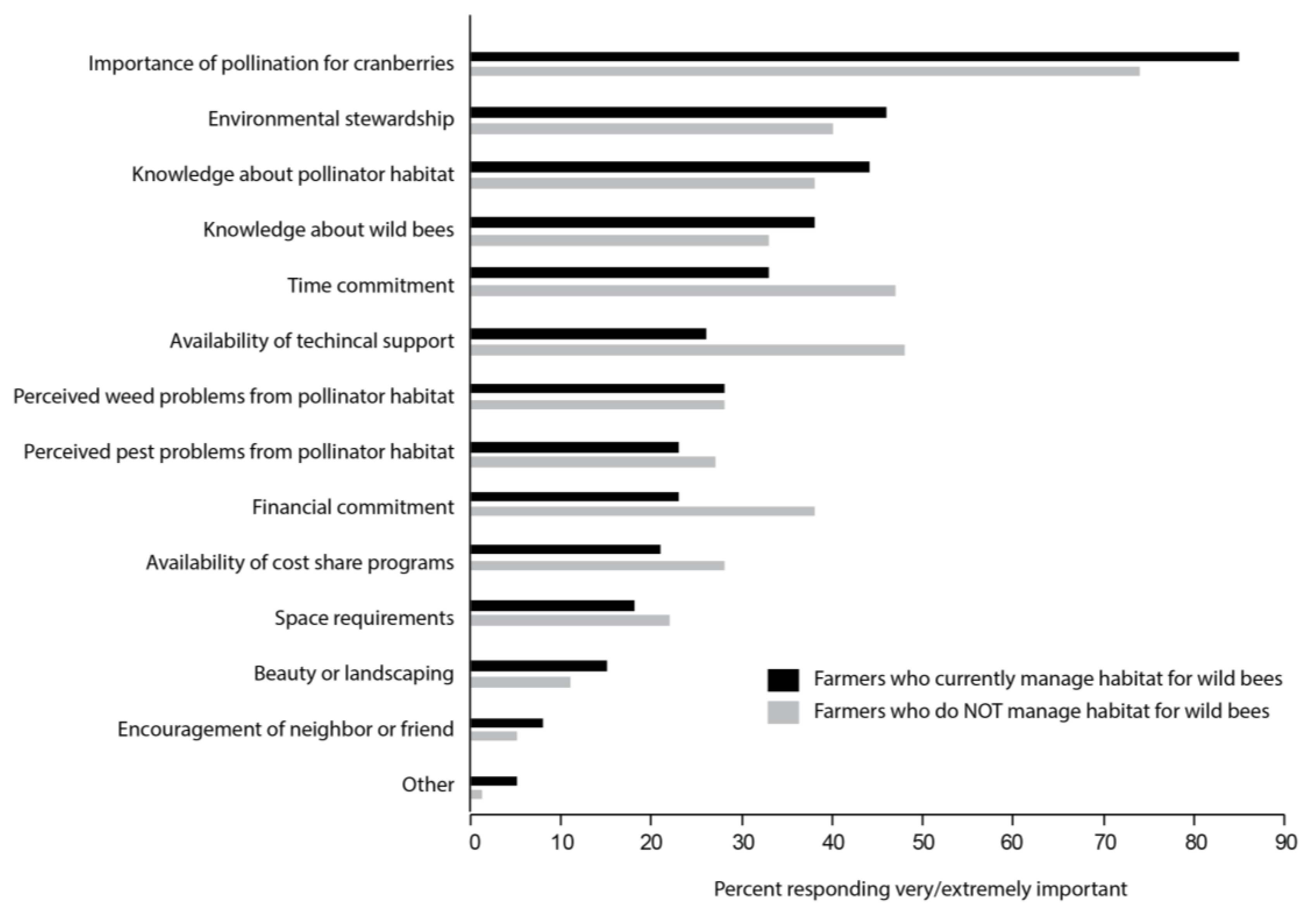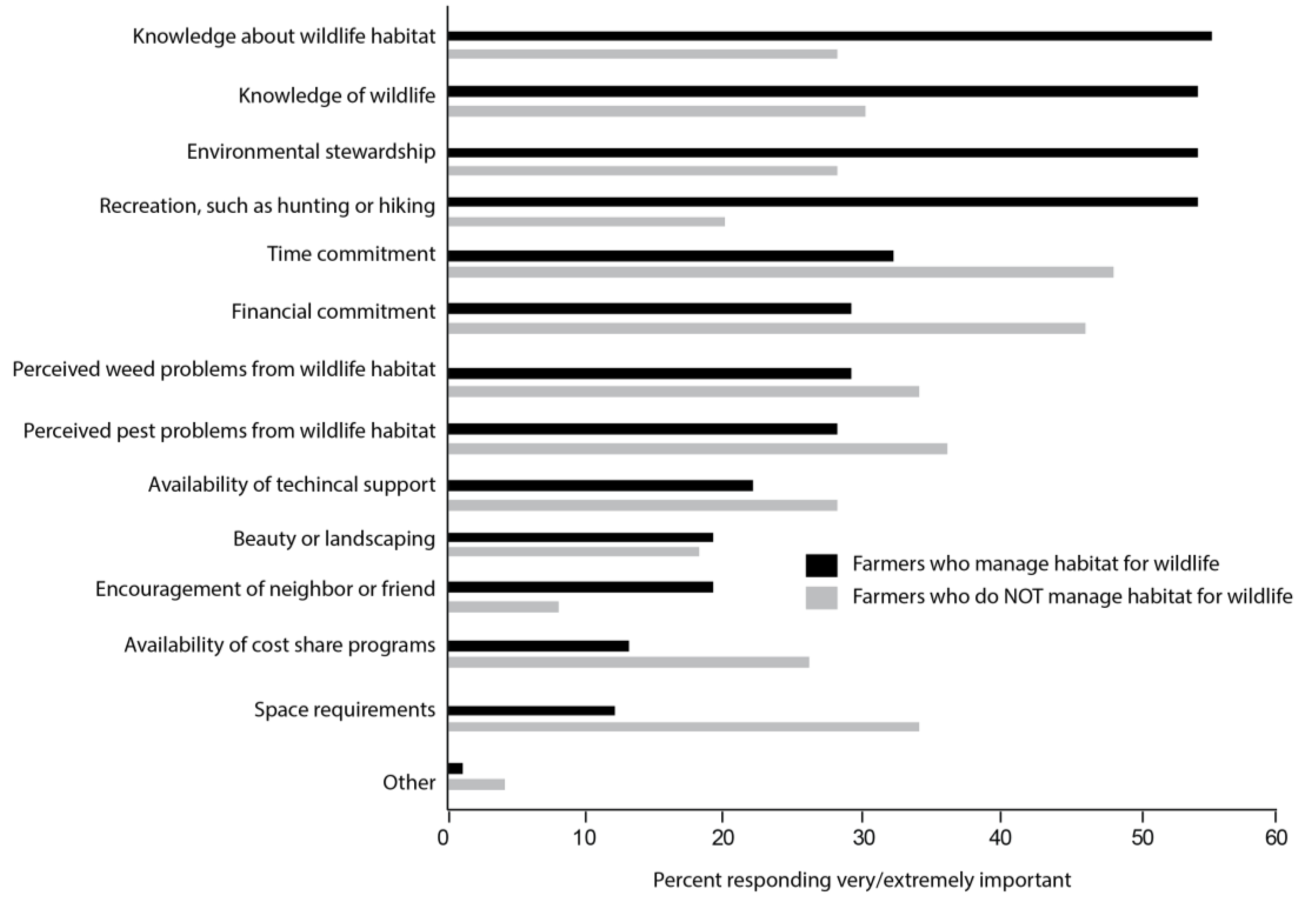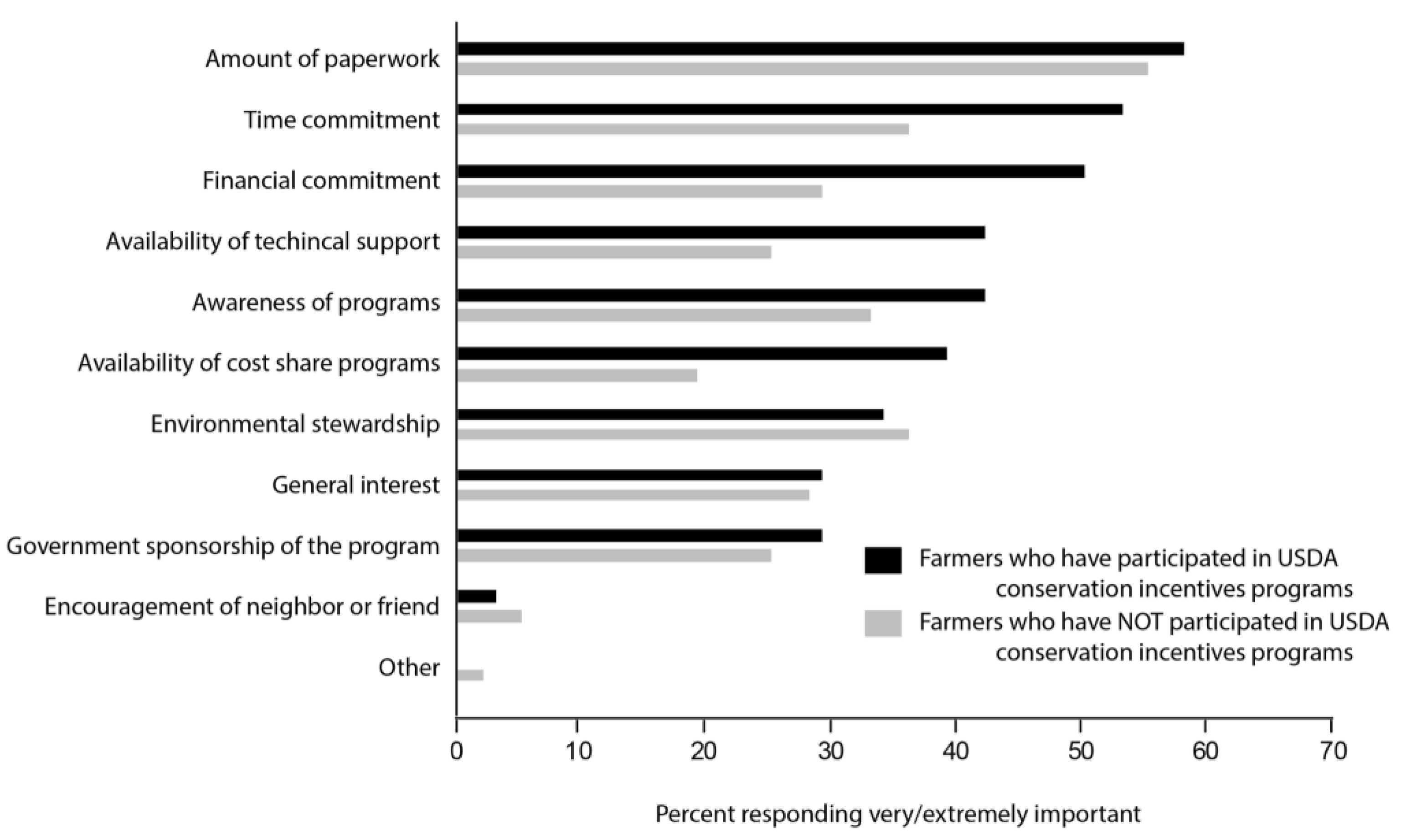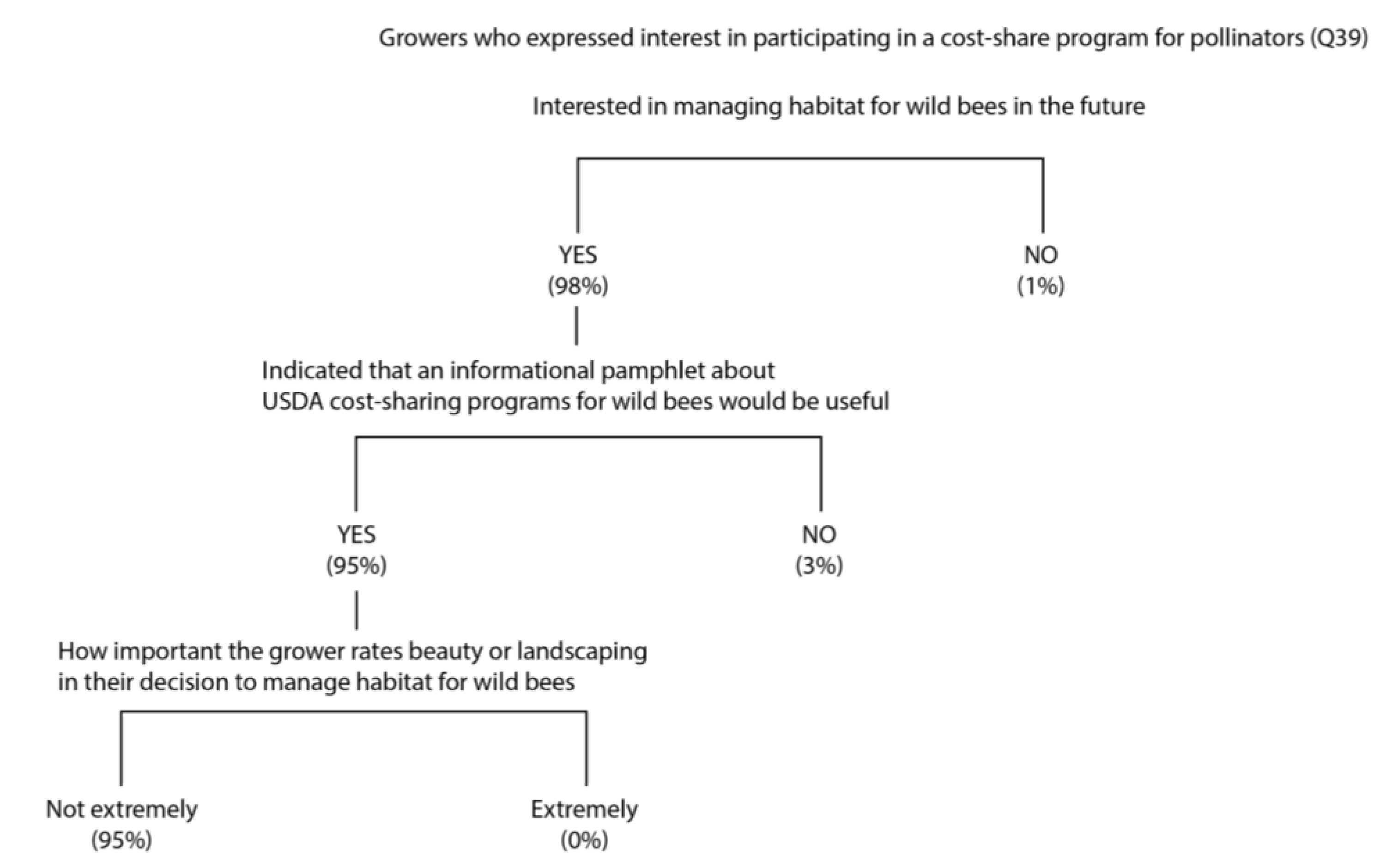Understanding Barriers to Participation in Cost-Share Programs For Pollinator Conservation by Wisconsin (USA) Cranberry Growers
Abstract
:1. Introduction
2. Materials and Methods
2.1. Grower Survey
2.2. Statistical Analysis
3. Results
3.1. Survey Response and Demographics
3.2. Active Management for Bees
3.3. Active Management of Wildlife Habitat
3.4. Participation in Conservation Cost-Share Programs
3.5. Sources of Management Information for Growers
4. Discussion
5. Conclusions
Supplementary Materials
Acknowledgments
Author Contributions
Conflicts of Interest
References
- Benton, T.G.; Vickery, J.A.; Wilson, J.D. Farmland biodiversity: Is habitat heterogeneity the key? Trends Ecol. Evol. 2003, 18, 182–188. [Google Scholar] [CrossRef]
- Foley, J.A.; DeFries, R.; Asner, G.P.; Barford, C.; Bonan, G.; Carpenter, S.R.; Chapin, F.S.; Coe, M.T.; Daily, G.C.; Gibbs, H.K. Others Global consequences of land use. Science 2005, 309, 570. [Google Scholar] [CrossRef] [PubMed]
- Losey, J.E.; Vaughan, M. The economic value of ecological services provided by insects. Bioscience 2006, 56, 311–323. [Google Scholar] [CrossRef]
- Isaacs, R.; Tuell, J.; Fiedler, A.; Gardiner, M.; Landis, D. Maximizing arthropod-mediated ecosystem services in agricultural landscapes: The role of native plants. Front. Ecol. Environ. 2009, 7, 196–203. [Google Scholar] [CrossRef]
- Wade, M.R.; Gurr, G.M.; Wratten, S.D. Ecological restoration of farmland: Progress and prospects. Philos. Trans. R. Soc. B-Biol. Sci. 2008, 363, 831–847. [Google Scholar] [CrossRef] [PubMed]
- Merckx, T.; Feber, R.E.; Riordan, P.; Townsend, M.C.; Bourn, N.A.D.; Parsons, M.S.; Macdonald, D.W. Optimizing the biodiversity gain from agri-environment schemes. Agric. Ecosyst. Environ. 2009, 130, 177–182. [Google Scholar] [CrossRef]
- Scheper, J.; Holzschuh, A.; Kuussaari, M.; Potts, S.G.; Rundlöf, M.; Smith, H.G.; Kleijn, D. Environmental factors driving the effectiveness of European agri-environmental measures in mitigating pollinator loss—A meta-analysis. Ecol. Lett. 2013, 16, 912–920. [Google Scholar] [CrossRef] [PubMed]
- Morandin, L.A.; Kremen, C. Hedgerow restoration promotes pollinator populations and exports native bees to adjacent fields. Ecol. Appl. 2013, 23, 829–839. [Google Scholar] [CrossRef] [PubMed]
- Vaughan, M.; Skinner, M. Using Farm Bill Programs for Pollinator Conservation; USDA Natural Resources Conservation Service National Plant Data Center: Honolulu, HI, USA, 2008.
- Using 2014 Farm Bill Programs for Pollinator Conservation. In Biology Technical Note NO. 78, 2nd ed.; USDA: South San Francisco, CA, USA, 2014.
- Xerces Society for Invertebrate Conservation. Invertebrate Conservation Fact Sheet: 2008 Farm Bill: Benefits to Crop Pollinators. Available online: http://www.xerces.org/wp-content/uploads/2008/11/2008_farm_bill_-fact_sheet_xerces_society.pdf (accessed on 31 July 2017).
- Delaplane, K.S.; Mayer, D.F. Crop Pollination by Bees; CABI Publishing: New York, NY, USA, 2000; ISBN 978-0-85199-783-4. [Google Scholar]
- Gaines-Day, H.R.; Gratton, C. Biotic and abiotic factors contribute to cranberry pollination. J. Pollinat. Ecol. 2015, 15, 15–22. [Google Scholar]
- Gaines-Day, H.R.; Gratton, C. Crop yield is correlated with honey bee hive density but not in high-woodland landscapes. Agric. Ecosyst. Environ. 2016, 218, 53–57. [Google Scholar] [CrossRef]
- Colquhoun, J.; Johnson, H. Sustainable Cranberry Production for a Vibrant Future: The Wisconsin Experience; University of Wisconsin Extension: Madison, WI, USA, 2010. [Google Scholar]
- Cane, J.H.; Schiffhauer, D. Dose-response relationships between pollination and fruiting refine pollinator comparisons for cranberry (Vaccinium macrocarpon [Ericaceae]). Am. J. Bot. 2003, 90, 1425–1432. [Google Scholar] [CrossRef] [PubMed]
- Alston, J.M.; Medellin-Azuara, J.; Saitone, T.L. Economic Impact of the North American Cranberry Industry; University of California: Davis, CA, USA, 2014. [Google Scholar]
- Ammel, J.; USDA Natural Resources Conservation Service: Stevens Point, WI, USA; Hannah, R.G.D.; University of Wisconsin-Madison, Madison, WI, USA. Personal communication, 2011.
- Mendham, E.; Millar, J.; Curtis, A. Landholder participation in native vegetation management in irrigation areas. Ecol. Manag. Restor. 2007, 8, 42–48. [Google Scholar] [CrossRef]
- Reimer, A.P.; Prokopy, L.S. Farmer Participation in U.S. Farm Bill Conservation Programs. Environ. Manag. 2014, 53, 318–332. [Google Scholar] [CrossRef] [PubMed]
- McCann, L.; Claassen, R. Farmer Transaction Costs of Participating in Federal Conservation Programs: Magnitudes and Determinants. Land Econ. 2016, 92, 256–272. [Google Scholar] [CrossRef]
- Lemke, A.M.; Lindenbaum, T.T.; Perry, W.L.; Herbert, M.E.; Tear, T.H.; Herkert, J.R. Effects of outreach on the awareness and adoption of conservation practices by farmers in two agricultural watersheds of the Mackinaw River, Illinois. J. Soil Water Conserv. 2010, 65, 304–315. [Google Scholar] [CrossRef]
- Hanes, S.P.; Collum, K.K.; Hoshide, A.K.; Asare, E. Grower perceptions of native pollinators and pollination strategies in the lowbush blueberry industry. Renew. Agric. Food Syst. 2015, 30, 124–131. [Google Scholar] [CrossRef]
- Abaidoo, S.; Dickinson, H. Alternative and Conventional Agricultural Paradigms: Evidence From Farming in Southwest Saskatchewan. Rural Sociol. 2002, 67, 114–131. [Google Scholar] [CrossRef]
- Pfrimmer, J.; Gigliotti, L.; Stafford, J.; Schumann, D.; Bertrand, K. Motivations for Enrollment Into the Conservation Reserve Enhancement Program in the James River Basin of South Dakota. Hum. Dimens. Wildl. 2017, 0, 1–8. [Google Scholar] [CrossRef]
- Dillman, D.A. Internet, Mail, and Mixed-Mode Surveys: The Tailored Design Method, 3rd ed.; Wiley & Sons: Hoboken, NJ, USA, 2009. [Google Scholar]
- Therneau, T.; Atkinson, B.; Ripley, B. rpart: Recursive partitioning and regression trees. R Package Version 2015, 4, 1–10. [Google Scholar]
- R Core Team. R: A Language and Environment for Statistical Computing; R Foundation for Statistical Computing: Vienna, Austria, 2015; ISBN 3-900051-07-0. [Google Scholar]
- De’ath, G.; Fabricius, K.E. Classification and regression trees: A powerful yet simple technique for ecological data analysis. Ecology 2000, 81, 3178–3192. [Google Scholar] [CrossRef]
- Chang, L.-Y.; Wang, H.-W. Analysis of traffic injury severity: An application of non-parametric classification tree techniques. Accid. Anal. Prev. 2006, 38, 1019–1027. [Google Scholar] [CrossRef] [PubMed]
- Doll, J.E.; Jackson, R.D. Wisconsin farmer attitudes regarding native grass use in grazing systems. J. Soil Water Conserv. 2009, 64, 276. [Google Scholar] [CrossRef]
- USDA-NASS, Census of Agriculture-Publications-2012. Available online: https://www.agcensus.usda.gov/Publications/2012/ (accessed on 30 June 2017).
- van Zoeren, J. Impacts of Spring Flooding on Carnivore and Detritivore Populations in Wisconsin Cranberries: Implications for Biocontrol. Master’s Thesis, University of Wisconsin, Madison, WI, USA, 2015. [Google Scholar]
- Greiner, R.; Gregg, D. Farmers’ intrinsic motivations, barriers to the adoption of conservation practices and effectiveness of policy instruments: Empirical evidence from northern Australia. Land Use Policy 2011, 28, 257–265. [Google Scholar] [CrossRef]
- Banack, S.A.; Hvenegaard, G.T. Motivations of landowners to engage in biodiversity-friendly farming practices in Alberta’s central parkland region. Hum. Dimens. Wildl. 2010, 15, 67–69. [Google Scholar] [CrossRef]
- Park, M. Importance, Drivers and Conservation of Wild Bees for Apple Pollination. Ph.D. Thesis, Cornell University, Ithaca, NY, USA, 2014. [Google Scholar]
- FSA CRP-SAFE Native Pollinator Planting. Available online: https://www.fsa.usda.gov/Internet/FSA_File/native_pollinator.pdf (accessed on 31 July 2017).
- Whitten, S.M.; Reeson, A.; Windle, J.; Rolfe, J. Designing conservation tenders to support landholder participation: A framework and case study assessment. Ecosyst. Serv. 2012. [Google Scholar] [CrossRef]
- Reimer, A.; Prokopy, L. One federal policy, four different policy contexts: An examination of agri-environmental policy implementation in the Midwestern United States. Land Use Policy 2014, 38, 605–614. [Google Scholar] [CrossRef]
- USDA Natural Resources Conservation Service. Available online: www.nrcs.usda.gov (accessed on 21 July 2017).
- Traoré, N.; Landry, R.; Amara, N. On-farm adoption of conservation practices: The role of farm and farmer characteristics, perceptions, and health hazards. Land Econ. 1998, 74, 114–127. [Google Scholar] [CrossRef]
- White, S.S.; Selfa, T. Shifting lands: Exploring Kansas farmer decision-making in an era of climate change and biofuels production. Environ. Manag. 2013, 51, 379–391. [Google Scholar] [CrossRef] [PubMed]
- Vaughan, M.; Mader, E. Pollinator biology and habitat. In Wisconsin Biology Technical Note 8; U.S. Department of Agriculture Nature Researchs Conservation Service: Washington, DC, USA, 2008. [Google Scholar]
- Vaughan, M.; Lee-Mader, E.; Guisse, J.; Goldenetz-Dollar, J.; Hopwood, J.; Borders, B.; Hirsch, R. Conservation Cover (327) for Pollinators: Upper Midwest Installation Guide and Job Sheet 2012; The University of Wisconsin: Masison, WI, USA, 2012. [Google Scholar]
- Volenberg, D.; Jensen, B. Cranberry Grower Education. Available online: www.uwex.edu/ces/ag/teams/fruit/ (accessed on 27 September 2013).
- Hall, J.A.; Fleishman, E. Demonstration as a Means to Translate Conservation Science into Practice. Conserv. Biol. 2010, 24, 120–127. [Google Scholar] [CrossRef] [PubMed]
- Healthy Grown Potatoes. Available online: www.healthygrown.com (accessed on 31 July 2017).
- Eco-Apple Program. Available online: www.redtomato.org/eco-apple/ (accessed on 31 July 2017).
- DeSilver, D. How the most ideologically polarized Americans live different lives. Pew Res. Cent. 2014. Available online: http://www.pewresearch.org/fact-tank/2014/06/13/big-houses-art-museums-and-in-laws-how-the-most-ideologically-polarized-americans-live-different-lives/ (accessed on 31 July2017).
- Klein, A.M.; Vaissiere, B.E.; Cane, J.H.; Steffan-Dewenter, I.; Cunningham, S.A.; Kremen, C.; Tscharntke, T. Importance of pollinators in changing landscapes for world crops. Proc. R. Soc. B Biol. Sci. 2007, 274, 303. [Google Scholar] [CrossRef] [PubMed]
- Wratten, S.D.; Gillespie, M.; Decourtye, A.; Mader, E.; Desneux, N. Pollinator habitat enhancement: Benefits to other ecosystem services. Agric. Ecosyst. Environ. 2012, 159, 112–122. [Google Scholar] [CrossRef]
- Presidential Memorandum-Creating a Federal Strategy to Promote the Health of Honey Bees and Other Pollinators. Available online: https://obamawhitehouse.archives.gov/the-press-office/2014/06/20/presidential-memorandum-creating-federal-strategy-promote-health-honey-b (accessed on 8 July 2017).





| Growing Region | County | Number of Farms (2012 NASS) | Number of Farms Responding (2011) | Percent of Total Cranberry Farms in Wisconsin (%) | Percent of Respondents (%) * | Response Rate (%) ** |
|---|---|---|---|---|---|---|
| Central | Adams | 9 | 7 | 4 | 6 | 78 |
| Buffalo | 1 | 0 | <1 | 0 | 0 | |
| Jackson | 36 | 23 | 15 | 19 | 64 | |
| Juneau | 8 | 11 | 3 | 9 | >100 | |
| Monroe | 62 | 22 | 26 | 18 | 35 | |
| Portage | 14 | 3 | 6 | 2 | 21 | |
| Waushara | 1 | 0 | <1 | 0 | 0 | |
| Wood | 72 | 46 | 30 | 38 | 64 | |
| SUB-TOTAL | 203 | 112 | 84 | 92 | 55 | |
| Northern | Ashland | 1 | 0 | <1 | 0 | 0 |
| Burnett | 1 | 0 | <1 | 0 | 0 | |
| Iron | 3 | 0 | 1 | 0 | 0 | |
| Lincoln | 1 | 2 | 0 | 2 | >100 | |
| Oconto | 2 | 0 | 1 | 0 | 0 | |
| Oneida | 11 | 5 | 5 | 4 | 45 | |
| Price | 3 | 2 | 1 | 2 | 67 | |
| Rusk | 1 | 0 | <1 | 0 | 0 | |
| Sawyer | 8 | 1 | 3 | 1 | 13 | |
| Vilas | 5 | 4 | 2 | 3 | 80 | |
| Washburn | 2 | 1 | 1 | 1 | 50 | |
| SUB-TOTAL | 38 | 15 | 16 | 12 | 39 | |
| TOTAL | 241 | 127 |
© 2017 by the authors. Licensee MDPI, Basel, Switzerland. This article is an open access article distributed under the terms and conditions of the Creative Commons Attribution (CC BY) license (http://creativecommons.org/licenses/by/4.0/).
Share and Cite
Gaines-Day, H.R.; Gratton, C. Understanding Barriers to Participation in Cost-Share Programs For Pollinator Conservation by Wisconsin (USA) Cranberry Growers. Insects 2017, 8, 79. https://doi.org/10.3390/insects8030079
Gaines-Day HR, Gratton C. Understanding Barriers to Participation in Cost-Share Programs For Pollinator Conservation by Wisconsin (USA) Cranberry Growers. Insects. 2017; 8(3):79. https://doi.org/10.3390/insects8030079
Chicago/Turabian StyleGaines-Day, Hannah R., and Claudio Gratton. 2017. "Understanding Barriers to Participation in Cost-Share Programs For Pollinator Conservation by Wisconsin (USA) Cranberry Growers" Insects 8, no. 3: 79. https://doi.org/10.3390/insects8030079






